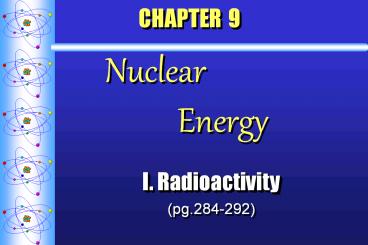CHAPTER 9 Nuclear Energy - PowerPoint PPT Presentation
Title:
CHAPTER 9 Nuclear Energy
Description:
CHAPTER 9 Nuclear Energy I. Radioactivity (pg.284-292) Other benefits to radiation Smoke detectors Disease detection Ultra sound CT scan MRI Cancer treatment 1 1 ... – PowerPoint PPT presentation
Number of Views:219
Avg rating:3.0/5.0
Title: CHAPTER 9 Nuclear Energy
1
CHAPTER 9 Nuclear Energy
- I. Radioactivity
- (pg.284-292)
2
Radioactive Elements
3
A. Definitions
- Radioactivity
- Process of unstable nuclei of elements becoming
stable through emitting particles or releasing
energy away from the atom - Also called nuclear decay
4
Definitions
- During nuclear decay, the element can transform
into a different isotope of the same element or
to a different element completely. - Transmutation
- process of changing one element into another
element by nuclear decay
5
Definitions
- Nuclear radiation is the released energy and
matter during nuclear decay. - This can have both positive and negative effects
for life on earth.
6
Definitions
- Isotopes elements that have the same number of
protons but different number of neutrons in their
nuclei.
7
Isotopes
- Carbon-12, Carbon-13, Carbon-14
8
Where does this take place?
- Radioactivity (nuclear decay) happens in the
nucleus of the atom.
9
B. Types of Radiation
- Alpha (?)
- helium nucleus
paper
2
- Beta-minus (?-)
- electron
plastic
1-
- Gamma (?)
- high-energy photon
lead
0
10
Types of Radiation
- Neutron emission (n) 1
- 0 n 0 charge
11
C. Nuclear Decay
- Why some nuclei decay
- to obtain a stable ratio of neutrons to protons
Stable
Unstable (radioactive)
12
C. Nuclear Decay
TRANSMUTATION
- Alpha Emission
- Beta Emission
13
Example
- Actinium-217 decays by releasing an alpha
particle. Write the equation for this decay
process and determine what element is formed. - Step 1 Write the equation with the original
element on the reactant side and products on the
right side.
14
Example
- 217 A 4
- 89 Ac ? Z X 2 He
- Step 2 Write math equations for the atomic and
mass numbers. - 217 A 4
- 89 Z 2
15
Example
- Step 3 Rearrange the equations.
- A 217 4 Z 89 - 2
- Step 4Solve for the unknown value, and rewrite
the equation with all nuclei. - A 213 Z 87
16
Example
- 217 213 4
- 89 Ac ? 87 Fr 2 He
- This is an example of alpha decay.
17
D. Half-life
- Half-life (t½)
- time it takes for half of the radioactive nuclei
in a sample to decay
18
Half-life
19
(No Transcript)
20
If we start out with 1 gram of the
parent isotope, after the passage of 1 half-life,
there will be 0.5 gram of the parent isotope
left.
21
D. Half-life
- How much of a 20-g sample of sodium-24 would
remain after decaying for 30 hours? Sodium-24
has a half-life of 15 hours.
GIVEN total time 30 hours t1/2 15
hours original mass 20 g
WORK number of half-lives 2 20 g 2 10 g
(1 half-life) 10 g 2 5 g (2
half-lives) 5 g of 24Na would remain.
22
Nuclear Forces
- There are two types of forces in the nucleus.
- Strong nuclear force helps attract the protons
and neutrons in the nucleus and keep them
together. - Repulsive force- protons repel each other because
they are the same charge
23
Nuclear Forces
In stable atoms, the attractive forces are
stronger than the repulsive forces.
24
A. F ission
- splitting a nucleus into two or more smaller
nuclei - some mass is converted to large amounts of energy
25
A. F ission
- chain reaction - self-feeding reaction
26
Fission
- Chain reactions can be controlled and used to
create electricity in nuclear power plants. - The minimum amount of a substance that can
undergo a fission reaction and sustain a chain
reaction is called critical mass.
27
B. Fusion
- combining of two nuclei to form one nucleus of
larger mass - produces even more energy than fission
- occurs naturally in stars
28
Fusion
29
Nuclear Radiation in Life
- Background radiation is nuclear radiation that is
around you from natural sources like the sun,
soil, rocks, and space. - A rem or millirem (1 rem 1000millirems) is the
unit for radiation.
30
Nuclear Radiation in Life
- A safe limit is set at 5000 millirems/year.
- Occupation X-ray tech, flight attendant
- Where you live- high elevation, near rocks
- Activities - smoking
31
A. Nuclear Power
- Fission Reactors
32
A. Nuclear Power
- Fusion Reactors (not yet sustainable)
National Spherical Torus Experiment
Tokamak Fusion Test Reactor Princeton University
33
A. Nuclear Power
FISSION
FUSION
vs.
- 235U is limited
- danger of meltdown
- toxic waste
- thermal pollution
- Hydrogen is abundant
- no danger of meltdown
- no toxic waste
- not yet sustainable
34
Other benefits to radiation
- Smoke detectors
- Disease detection
- Ultra sound
- CT scan
- MRI
- Cancer treatment































